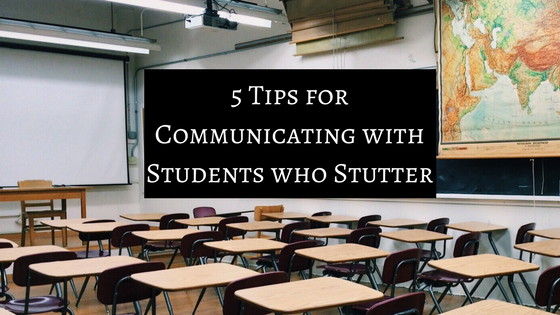
School is finally back in session! With every new school year come new stresses, expectations, and faces. In speaking to a few teacher colleagues and friends, it’s become apparent that teachers are often not taught how to communicate with students with disabilities, particularly students who stutter. Without this knowledge, both students and teachers are put in an uncomfortable situation. For that reason, I decided to write this blog post to provide teachers with 5 tips on communicating with students who stutter and, in turn, help all students feel more comfortable speaking in the classroom. This blog post is based off of my YouTube video 5 Stuttering Tips for Teachers.
Here are the 5 tips:
1) Avoid saying, “slow down” or “think about what you want to say”
- This is probably the most important of the 5 tips. Stuttering is not an issue of speaking too quickly or not thinking, so using these phrases with a student who stutters will have no positive effect. In fact, using these phrases may cause frustration or anxiety for the student who stutters.
2) Don’t complete your student’s sentence/thought
- If your student is in the midst of a stutter, completing his sentence/thought is not going to help the situation. Your student has his own unique thoughts and ideas and likely wants to share them like any other student. Although it may take a student who stutters longer to express himself, doesn’t mean he shouldn’t be afforded the opportunity. The best thing you can do as a teacher is to be patient and give the student ample time to speak.
3) Give your student an opportunity to educate his peers about stuttering
- Unfortunately many children with disabilities are bullied or mocked because their peers don’t understand their situations. It could be helpful to do lessons on disabilities and/or acceptance, as well as allow your student who stutters to present or do a project on the topic.
4) Monitor your own body language when communicating with a student who stutters
- You may feel uncomfortable communicating with your student who stutters because you don’t know how to help. If you feel this way, it could be evidenced in your body language by avoiding eye contact, looking away, etc., so be mindful of how you are reacting to the stutter both verbally and nonverbally.
5) Model slow, relaxed speech
- By modeling slow, relaxed speech your student may feel more comfortable communicating with you and may also try and imitate your rate which, in turn, may have a positive effect on the student’s stuttering episode.
I hope you find these tips helpful in communicating with your students who stutter. Please leave a comment with tips you’ve found to be the most helpful when communicating and interacting with students with disabilities.

